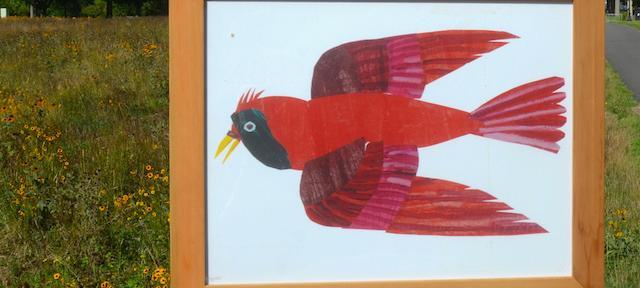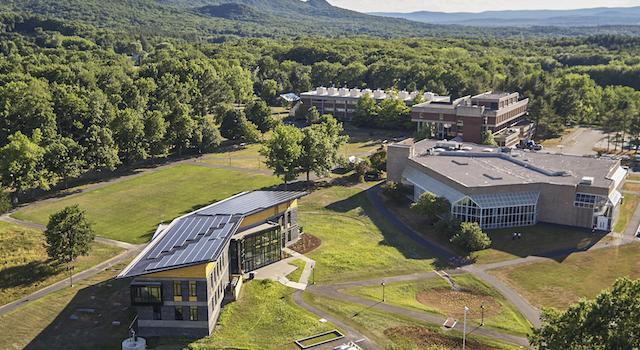Hampshire Welcomes Exhibit Display for 'Brown Bear' Picture Book 50th Anniversary

Hampshire College is helping to celebrate the upcoming 50th anniversary of one of the best-selling picture books of all time – Brown Bear, Brown Bear, What Do You See? illustrated by Eric Carle – by hosting one of 14 reproductions comprising an expansive and heartwarming outdoor exhibit throughout the town of Amherst.
This special exhibit, Brown Bear Everywhere, on view through October 9, 2016, brings the high-quality reproductions of Carle’s original collage illustrations to some of Amherst’s most popular sites.
The exhibit kicks off a year of special events by the Eric Carle Museum of Picture Book Art in celebration of the book written by Bill Martin Jr. and illustrated by Eric Carle, launching his career.
The museum chose Hampshire College to host the framed reproduction of Carle’s illustration titled Red Bird, because “Hampshire has been so diligent about creating plantings that support songbirds,” explains the museum’s Marketing Manager Sandy Soderberg. The illustration is exhibited in the center of campus in one of the College’s recently restored wildflower meadows. “We love the wildflower field and could imagine Red Bird flying through it,” Soderberg said.
In the 2013-14 academic year, Hampshire students, faculty and staff led what President Jonathan Lash dubbed a “dethroning of the automobile” by redesigning the center of campus for use by people and birds instead of cars. The College converted a road and bus stop between Franklin Patterson Hall and the Robert Crown Center into a meadow, and also converted acres of mowed lawns to meadows to avoid thousands of pounds of CO2 emissions, and provide habitat for birds including kestrels, king birds, red-wings, bluebirds, and bobolinks.
In addition to Hampshire’s campus, the anniversary exhibit’s framed reproductions are displayed at Amherst Commons (White Dog), Bare Mountain (Brown Bear), Black Sheep Deli (Black Sheep), High Horse Restaurant (Blue Horse), Hitchcock Center for the Environment (Green Frog), Jones Library (Final Page), Amherst College Mead Art Museum (Endpapers), the University of Massachusetts campus pond (Yellow Duck) and five other sites.
An accompanying social media campaign asks fans to tag @carlemuseum and submit selfies taken in town with their favorite character using the hashtag #brownbeareverywhere. Selfies will be entered in a weekly drawing to win a Brown Bear anniversary tote bag.
“We enjoyed matching each picture in the book to a specific location in Amherst,” says Ellen Keiter, the Carle’s chief curator. “Perhaps my favorite is ‘Brown Bear’ atop Bare Mountain, the highest elevation in Amherst. It seems appropriate that Brown Bear look out over the Valley from this majestic perch.”
Around Hampshire’s campus is a Cultural Village that includes the Eric Carle museum opened in 2002 and the Yiddish Book Center opened in 1980, both independent organizations not directly affiliated with the College, but which share similar educational and programmatic values. The Cultural Village is expanding this year as Hampshire has entered a 95-year lease with Hitchcock Center for the Environment, relocating from its current home north of campus. Scheduled to open in its newly constructed living building adjacent to the Hampshire College Farm on September 13, The Hitchcock Center offers year-round environmental education programs serving over 8,000 children, youth, and adults each year.
The Brown Bear Everywhere exhibit kicks off a yearlong, nationwide celebration, including Brown Bear Turns 50! opening at the Carle Museum on September 13, 2016. Support for both exhibitions has been generously provided by Macmillan Children’s Publishing Group.
Published in 1967, Brown Bear, Brown Bear, What Do You See? has been translated into 31 languages—from Arabic to Vietnamese—and has sold more than 16 million copies.
The only full-scale museum of its kind in the United States, The Eric Carle Museum of Picture Book Art, a non-profit organization, collects, preserves, presents, and celebrates picture books and picture book illustrations from around the world, and offers educational programs that provide a foundation for arts integration and literacy. Eric Carle is author and illustrator of more than 70 books, including the 1969 classic The Very Hungry Caterpillar. Since opening, the facility has served more than half a million visitors. For further information, call (413) 559-6300 or visit the Museum’s website at www.carlemuseum.org



